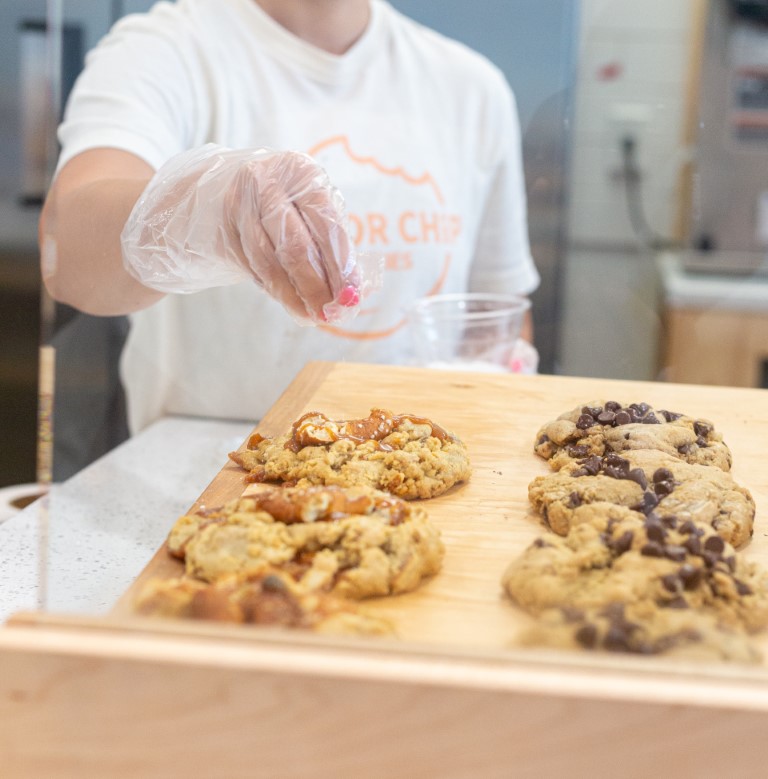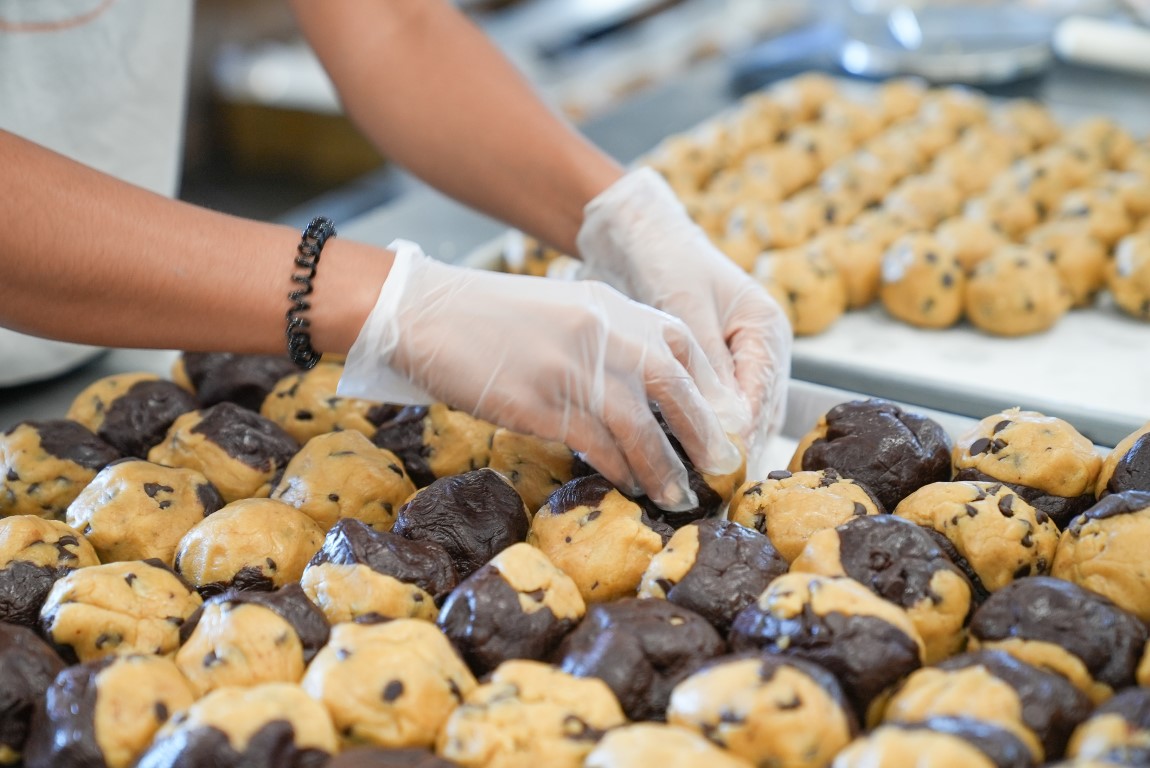You can microwave cookie dough, but it's vital to prioritize safety and proper techniques. Cookie dough often contains raw egg and untreated flour, which can harbor harmful bacteria. For a safer option, use heat-treated flour and a dough intended for quick cooking, such as edible cookie dough. Shape the dough evenly, using short microwave intervals on medium strength to prevent uneven cooking and hot spots. Rest the cookies after microwaving for even heat distribution and improved texture. Consider safe ingredients and proper settings to enhance the microwaving experience, exploring further will provide you with more information into achieving ideal results.
Key Takeaways
- Microwaving cookie dough is possible but requires careful attention to ensure even cooking and prevent health risks.
- Use microwave-safe bowls and medium settings to prevent overheating and uneven cooking of cookie dough.
- Select pre-made doughs labeled safe for microwaving, such as edible cookie dough or minute cookies.
- Cook dough in short bursts, checking frequently to avoid overcooking and ensure even heat distribution.
- Allow cookies to cool slightly post-cooking for improved texture and flavor.
Understanding Cookie Dough Safety
When considering cookie dough safety, it's important to understand the different types of dough and their ingredients, as these factors influence how safe it is to consume raw or microwaved. Some cookie doughs contain raw eggs or untreated flour, both of which can pose health risks if not properly cooked. By examining these ingredients and their potential hazards, you can make informed decisions about the safety of microwaving your cookie dough.
Types of Cookie Dough and Their Ingredients
Cookie dough comes in a variety of types, each with its unique ingredients, which are crucial for determining its safety, especially if you're considering microwaving it. Traditional cookie dough typically includes raw flour, unsalted butter, and chocolate chips. When making microwave cookies, understanding the role of each ingredient is imperative. Raw flour should be treated to guarantee a safe edible cookie dough recipe, as it can harbor bacteria. The cookie dough texture relies on the balance of unsalted butter and flour temperature, affecting the outcome of a microwave chocolate chip cookie. Pre-mixed cookie dough often provides convenience, but knowing its contents helps in evaluating safety. Always check that ingredients are suitable for microwave preparation to guarantee a pleasant and safe experience.
Risks and Safety Considerations
Microwaving cookie dough introduces several risks that you should be aware of to guarantee safety. When you microwave cookie dough, hot spots can occur, which means the dough may cook unevenly, leaving some parts raw. Raw cookie dough can contain harmful bacteria, making it essential to ascertain your cookie dough is safe. Always use microwave-safe containers to avoid any hazards. Unlike baking in a pre-heated oven, microwaving doesn't always yield an actual cookie, so follow a reliable microwave cookie recipe. Additionally, consider using heat-treated ready-to-eat flour to reduce risks. Mixing the dough in a medium bowl can help distribute heat more evenly. Keep these considerations in mind to enjoy your treat safely and effectively.
Microwaving Cookie Dough Successfully
To microwave cookie dough successfully, you'll need to start by choosing the right type of dough, such as pre-made doughs that are safe for quick cooking. Proper preparation involves shaping the dough evenly to guarantee uniform cooking, and using a microwave-safe dish to avoid any mishaps. For the best results, set your microwave to medium strength and cook in short bursts, typically between 20 to 40 seconds, checking frequently to avoid overcooking.
Best Cookie Dough Types for Microwaving
When it comes to microwaving cookie dough successfully, choosing the right type can make all the difference. Start with edible cookie dough, as it's safe to eat without baking. If you're after a quick treat, try a minute chocolate chip cookie using microwave cookie dough material. This type offers a gooey cookie texture, perfect for those craving a warm cookie dough experience before bed. Frozen cookie dough works too, but it requires more attention to achieve the right consistency. Experimenting can lead to delightful adventures in microwave cookie creations. To make your cookie nice and satisfying, focus on balancing cook time and dough type to prevent overcooking, ensuring the ideal gooey texture that makes microwaved cookies a delicious treat.
Proper Preparation Methods
Selecting the right cookie dough is just the beginning; now let's focus on how you can microwave it to perfection. Begin by forming cookie dough balls from chocolate chip cookie dough, adding a pinch of salt, a teaspoon of baking powder, a tablespoon of milk, and a drop of vanilla extract to enhance the flavors. Place the dough balls in a microwave-safe bowl instead of a preheated oven, ensuring they have enough space. While a baking sheet isn't necessary here, you're aiming for a perfect cookie dough experience. This method allows for a quick indulgence without compromising taste. Remember, microwaving doesn't replicate baking exactly, but with careful preparation, you can enjoy a delightful, warm cookie treat right from your microwave.
Recommended Microwave Settings and Times
Mastering the art of microwaving cookie dough requires knowing the right settings and times to achieve that perfect texture. Start by using medium microwave settings to prevent overcooking. A typical cook time for a regular chocolate chip cookie is around 40-60 seconds. If the dough before baking is gritty or dense, consider using heat-treated flour to enhance the texture. Once the microwave beeps, let the cookie hot rest for a minute; this minute rest time allows the heat to distribute evenly, avoiding any cookie dough gritty spots. Remember, using your favorite cookie ingredients can help replicate the flavors of a baking staple. By following these guidelines, you'll enjoy a quick, delicious treat without compromising on quality.
Step-By-Step Microwave Guide
To start microwaving cookie dough, gather essential tools like a microwave-safe plate and parchment paper, guaranteeing everything is ready before you begin. Shape and portion the dough into small, even balls to guarantee consistent cooking. Once cooked, allow the cookies to cool slightly before serving, and consider adding toppings like chocolate chips or a sprinkle of sea salt for extra flavor.
Essential Tools and Materials
When it comes to microwaving cookie dough, your kitchen's essentials can make all the difference. Start with an electric mixer to blend your ingredients smoothly. If you're inspired by cookie dough ice cream, consider integrating chunks into your mixture. Avoid using a cookie in foil, as metal can damage the microwave. Embrace cookie technology by using microwave-safe baking trays, perfect for microwave cookie dough. If you often visit a cookie dough shop, replicate their texture with a metal bowl for thorough mixing. Don't forget a teaspoon salt to enhance flavors in your cookie recipe. Each of these tools contributes to a successful microwaving experience, ensuring your homemade treats rival those from your favorite shop.
Shaping and Portioning the Dough
Concluding your dough preparation, it's time to shape and portion it for microwaving. Begin by using regular flour to dust your hands, preventing the cookie dough from sticking. For microwaving, it's best to create small, even portions, similar to frozen cookie balls. This guarantees the dough cooks uniformly. If you're following chocolate chip cookie recipes, make certain to shape each portion evenly, as gritty cookie dough might not spread like it would when you bake cookies traditionally.
Use a spoon or small scoop to measure out equal amounts of dough, then roll them gently into balls. This step is vital for achieving consistent homemade cookies. Once shaped, place the dough balls on a microwave-safe plate, leaving space between each to allow for expansion.
Cooking and Cooling Process
You've portioned your dough into even balls, and now it's time to cook them using your microwave. Unlike the oven method, microwaving cookie dough offers a quick alternative, though the results may differ slightly. Follow these steps for gooey cookies:
- Place dough balls on a microwave-safe plate instead of a rimmed baking sheet used for oven baking.
- Set the microwave to high, and adjust the cooking time to 40-60 seconds, depending on your preference for gooey or firmer chocolate chip cookies.
- Allow them to cool for a few minutes after cooking to complete the cooling process.
The purpose flour and teaspoons of vanilla extract in your dough will release delightful aromas. Remember, the microwave can't replicate the oven's texture, but it can satisfy your cookie craving swiftly!
Serving Suggestions and Toppings
Once your cookies are cooled and ready to serve, consider adding a personal touch with various toppings and serving suggestions to enhance the experience. A normal cookie can transform into a delightful treat by sprinkling mini chocolate chips on top or drizzling a teaspoon of vanilla glaze for added depth. For chocolate cookie dough desserts, a pinch of salt enhances the richness, bringing out your favorite flavor. If you've made peanut butter cookies, try adding a dollop of melted chocolate or a swirl of caramel. Sugar cookies pair beautifully with fresh fruit slices or a dusting of cinnamon. A fresh cookie, still warm, can be paired with a scoop of ice cream for a delicious contrast of temperatures and textures.
Troubleshooting and Tips
When microwaving cookie dough, you might encounter issues like uneven cooking or a rubbery texture, but with a few adjustments, you can achieve the perfect consistency. Pay attention to the microwave's energy settings and cooking time, adjusting them to suit your preferences and make certain the cookies don't overcook or remain underdone. While microwave-baked cookies might differ slightly in texture compared to their oven-baked counterparts, they offer a quick and convenient alternative when you're short on time.
Common Microwave Cooking Issues
Microwaving cookie dough can sometimes lead to unexpected results, causing frustration in the kitchen. To troubleshoot common issues, consider these tips:
-
Even Melting: Chocolate chips may not melt evenly. Stir the cookie dough halfway through cooking to distribute heat and avoid clumps.
-
Texture Problems: If you're aiming for chewy sugar cookies, microwaving might make them dry. To mimic a real cookie, try adding a bit more butter to enhance moisture and flavor brown.
-
Flavor Enhancement: The microwave can dull flavors. Mix in a sprinkle of kosher salt and guarantee the dough in your mixer bowl has a deep flavor before microwaving.
Achieving Your Desired Texture
To achieve your desired cookie texture in the microwave, understanding your dough's characteristics is key. Start with the right ingredients: brown sugar adds moisture and chewiness; plain flour or a cup of all-purpose flour provides structure. If you're aiming for gluten-free, substitute with gluten-free flour. Integrate your milk of choice to keep it rich and smooth. For buttery cookies, guarantee even distribution of butter throughout the dough. Add milk chocolate chips for a classic touch, or try chip cookie dough ice for something different. Avoid a dry-ass mug cake recipe outcome by adjusting the cook time, much like chocolate mug cakes. Keep experimenting until you find the microwave method that delivers the perfect texture for your taste.
Quality Comparison With Oven-Baked Cookies
Aesthetic satisfaction often drives our quest for the perfect cookie, whether baked in an oven or zapped in a microwave. When you immerse yourself in the quality comparison between microwave and oven-baked cookies, several factors come into play.
-
Texture: Oven-baked cookies often have a crisp edge and chewy center, thanks to the even temperature distribution. The microwave can yield a softer, sometimes rubbery consistency due to uneven heating.
-
Taste: Baking in an oven allows flavors to develop fully, whereas a microwave may not bring out the same depth of flavor from the cookie dough.
-
Moisture and Consistency: Oven-baked cookies usually retain a balanced moisture level, while the microwave might leave them drier or inconsistently baked, impacting overall taste and texture.
Our Journey to Cookie Perfection: Why Trust Our Baking Insights
At Taylor Chip, our expertise in cookie baking isn't just a skill—it's a passion that has grown alongside our relationship. Since 2015, Sara and Dougie Taylor have been on a relentless quest to create the perfect cookie, experimenting with various techniques, including unconventional methods like microwaving. This journey of culinary exploration has led us to develop a deep understanding of cookie science, from ingredient interactions to cooking methods. Our dedication to perfecting the cookie recipe culminated in 2016 when we felt we had achieved the ideal balance of flavor, texture, and consistency—just in time for our wedding. This milestone wasn't just personal; it marked the beginning of our professional venture into the world of gourmet cookies.
Our hands-on experience with various baking methods, including microwaving, gives us unique insights into the challenges and opportunities each technique presents. We've tested countless variations to bring you the most reliable advice on creating delicious cookies, whether you're using a conventional oven or experimenting with your microwave.
Frequently Asked Questions
Can Microwaved Cookie Dough Be Refrozen After Cooking?
You might wonder if you can refreeze microwaved cookie dough after cooking. It's not recommended because the texture and quality might degrade. Instead, enjoy your freshly baked cookies or store them in an airtight container.
Does Microwaving Affect the Flavor of Cookie Dough?
Microwaving cookie dough can change its flavor. The quick heat may alter the texture and taste, making it less chewy and more cake-like. However, if you're craving cookies fast, it's a convenient option.
How Long Can Microwaved Cookies Stay Fresh?
Microwaved cookies can stay fresh for about 2-3 days if you store them in an airtight container. To keep them from drying out, consider adding a slice of bread. Enjoy your cookies while they're at their best!
Is It Safe to Microwave Gluten-Free Cookie Dough?
Yes, you can safely microwave gluten-free cookie dough. Make sure it reaches an internal temperature of 165°F to kill any bacteria. Use a microwave-safe dish and monitor closely to avoid overcooking or uneven baking. Enjoy your treat!
Can Microwaved Cookie Dough Be Used for Edible Cookie Dough Recipes?
You can use microwaved cookie dough for edible recipes, but verify it's safe by using heat-treated flour and pasteurized eggs. Microwaving can change texture, so adjust your expectations. Enjoy experimenting with your favorite flavors and toppings!
Conclusion
In summary, microwaving cookie dough is a convenient option if you follow safety guidelines and proper techniques. Start by ensuring the dough is safe for consumption, particularly if it contains raw eggs. Use a microwave-safe dish, and adjust the cooking time based on your microwave's strength. Monitor closely to prevent overcooking, as microwaves can heat unevenly. By following these steps, you can achieve a quick, satisfying treat with minimal effort and time investment.









